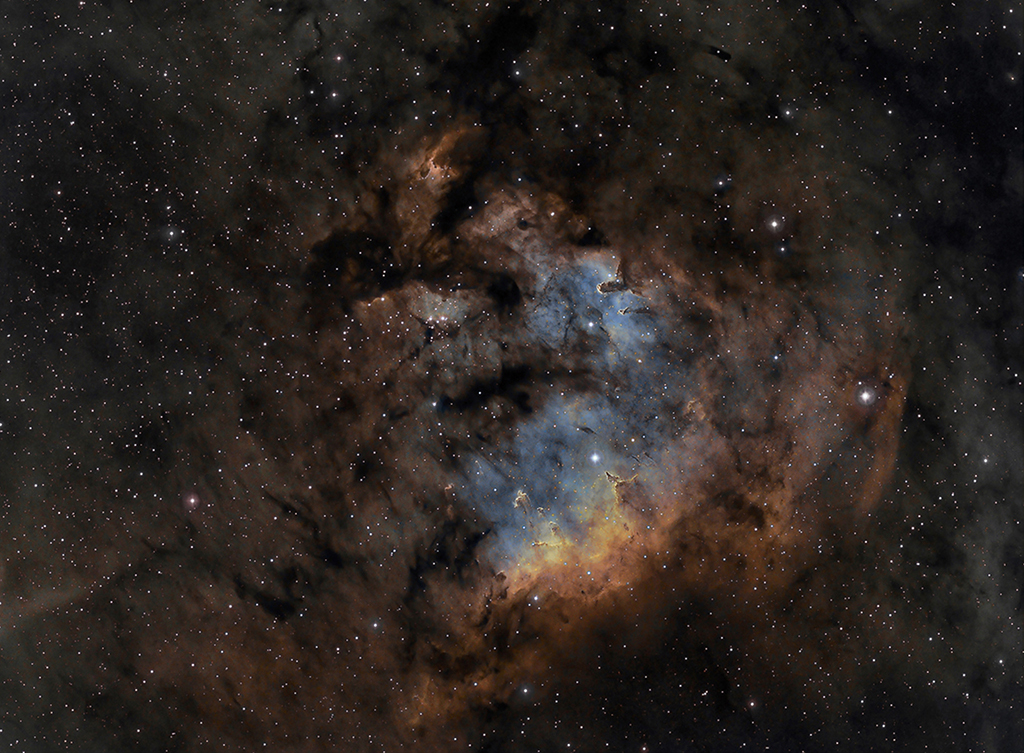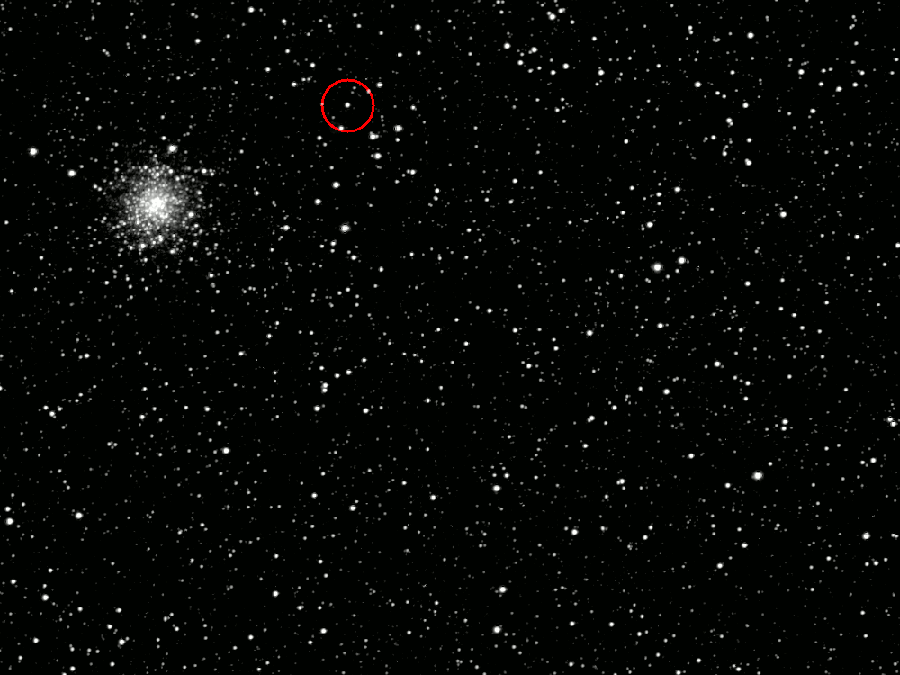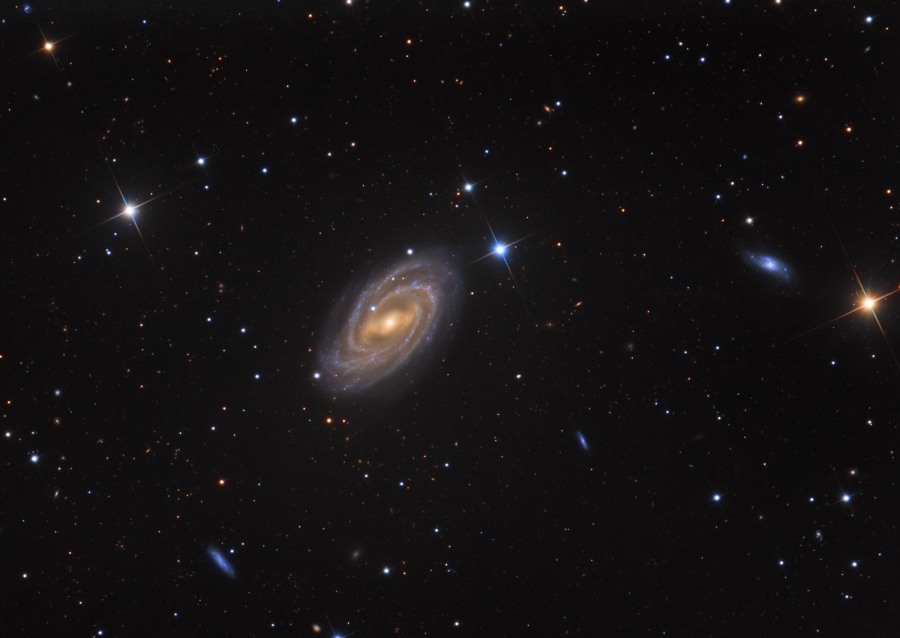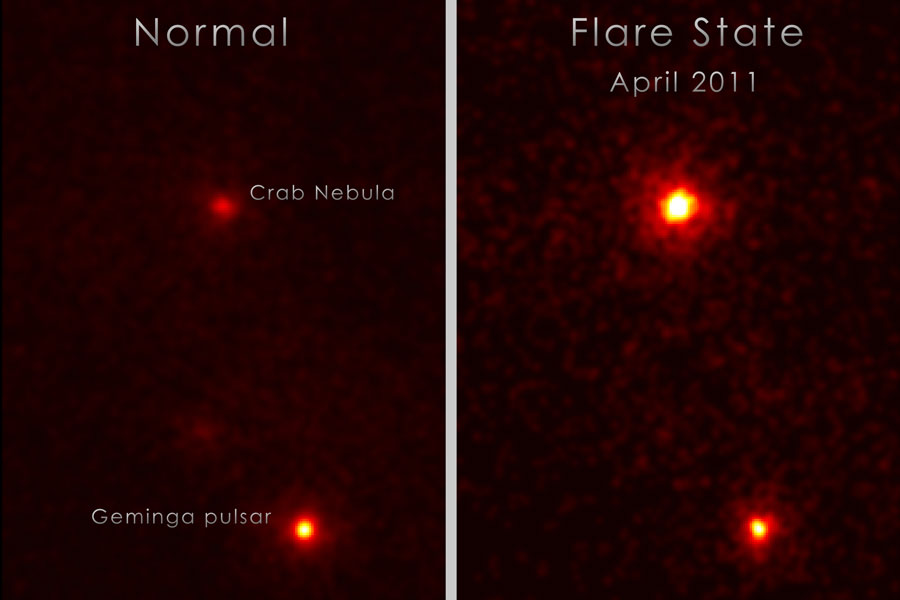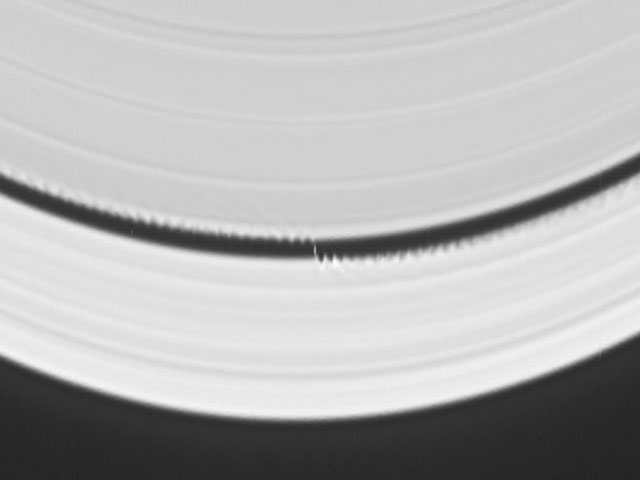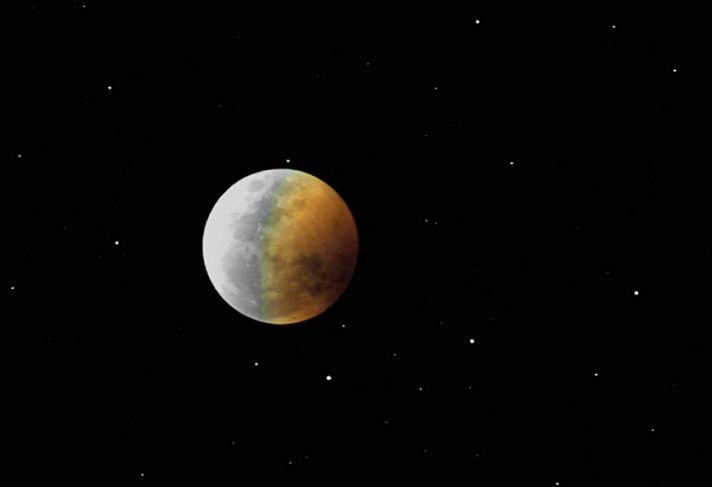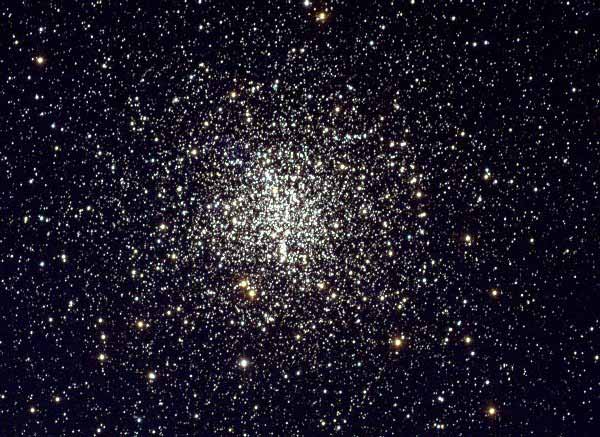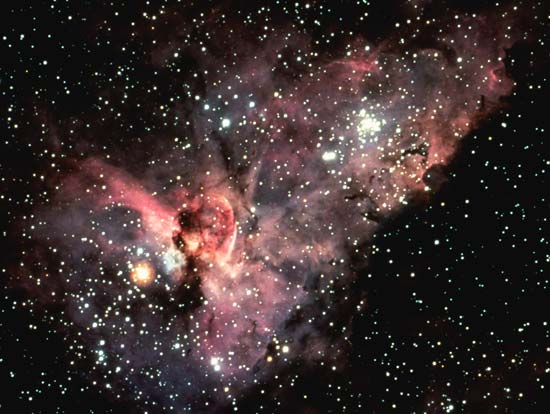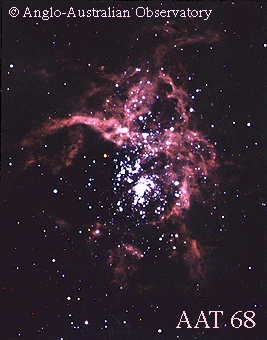| << Previous | Index | Next >> |
2015 Hot, young stars and cosmic pillars of gas and dust seem to crowd into NGC 7822. At the edge of a giant molecular cloud toward the northern constellation Cepheus, the glowing star forming region lies about 3,000 light-years away. Within the nebula, bright edges and dark shapes are highlighted in this colorful skyscape. The image includes data from narrowband filters, mapping emission from atomic oxygen, hydrogen, and sulfur into blue, green, and red hues. The atomic emission is powered by energetic radiation from the hot stars, whose powerful winds and radiation also sculpt and erode the denser pillar shapes. Stars could still be forming inside the pillars by gravitational collapse, but as the pillars are eroded away, any forming stars will ultimately be cutoff from their reservoir of star stuff. This field spans around 40 light-years at the estimated distance of NGC 7822.
2014 The Rosetta spacecraft captured this remarkable series of 9 frames between March 27 and May 4, as it closed from 5 million to 2 million kilometers of its target comet. Cruising along a 6.5 year orbit toward closest approach to the Sun next year, periodic comet 67P/Churyumov-Gerasimenko is seen moving past a distant background of stars in Ophiuchus and globular star cluster M107. The comet's developing coma is actually visible by the end of the sequence, extending for some 1300 km into space. Rosetta is scheduled for an early August rendezvous with the comet's nucleus. Now clearly active, the nucleus is about 4 kilometers in diameter, releasing the dusty coma as its dirty ices begin to sublimate in the sunlight. The Rosetta lander's contact with the surface of the nucleus is anticipated in November.
2013 Beautiful barred spiral galaxy M109, 109th entry in Charles Messier's famous catalog of bright Nebulae and Star Clusters, is found just below the Big Dipper's bowl in the northern constellation Ursa Major. In telescopic views, its striking central bar gives the galaxy the appearance of the Greek letter "theta", θ, a common mathematical symbol representing an angle. Of course M109 spans a very small angle in planet Earth's sky, about 7 arcminutes or 0.12 degrees. But that small angle corresponds to an enormous 120,000 light-year diameter at the galaxy's estimated 60 million light-year distance. The brightest member of the now recognized Ursa Major galaxy cluster, M109 (aka NGC 3992) is joined by three spiky foreground stars strung out across this frame. The three small, fuzzy bluish galaxies also on the scene, identified left to right as UGC 6969, UGC 6940 and UGC 6923, are possibly satellite galaxies of the larger M109.
2012
Click to play embedded YouTube video.
Image Credit: NASA
2011 Why does the Crab Nebula flare? No one is sure. The unusual behavior, discovered over the past few years, seems only to occur in very high energy light -- gamma rays. As recently as one month ago, gamma-ray observations of the Crab Nebula by the Fermi Gamma Ray Space Telescope showed an unexpected increase in gamma-ray brightness, becoming about five times the nebula's usual gamma-ray brightness, and fading again in only a few days. Now usually the faster the variability, the smaller the region involved. This might indicate that the powerful pulsar at the center of the Crab, a compact neutron star rotating 30 times a second, is somehow involved. Specifically, speculation is centered on the changing magnetic field that surely surrounds the powerful pulsar. Rapid changes in this field might lead to waves of rapidly accelerated electrons which emit the flares, possibly in ways similar to our Sun. The above image shows how the Crab Nebula normally appears in gamma rays, as compared to the Geminga pulsar, and how it then appeared during the recent brightening.
2010 That's no sunspot. On the upper right of the above image of the Sun, the dark patches are actually the International Space Station (ISS) and the Space Shuttle Atlantis on mission STS-132. In the past, many skygazers have spotted the space station and space shuttles as bright stars gliding through twilight skies, still glinting in the sunlight while orbiting about 350 kilometers above the Earth's surface. But here, astrophotographer Thierry Lagault accurately computed the occurrence of a rarer opportunity to record the spacefaring combination moving quickly in silhouette across the solar disk. He snapped the above picture on last Sunday on May 16, about 50 minutes before the shuttle docked with the space station. Atlantis was recently launched to the ISS for its last mission before being retired.
2009 Put on your red/blue glasses and gaze into this dramatic stereo view from the surface of the Moon. The 3D scene features Apollo 12 astronaut Pete Conrad visiting the Surveyor 3 spacecraft in November of 1969. The image was carefully created from two separate pictures (AS12-48-7133, AS12-48-7134) taken on the lunar surface. They depict the scene from only slightly different viewpoints, approximating the separation between human eyes. Combining images, one tinted red and the other blue-green, with the correct offset, produces the stereo effect when viewed using red/blue glasses, the red filter covering the left eye. The color filters guide each eye to see only the picture with the correct corresponding viewpoint. The particular pair of images chosen also required a slight tilt to optimize the stereo effect. While you've got those glasses on, web sources of astronomy and space science stereo images include the Mars Path Finder archive, a 3D Tour of the Solar System, and stereo experimenter Patrick Vantyune's own set of stereo images from the Apollo missions to the Moon.
2008 For about 300 years Jupiter's banded atmosphere has shown a remarkable feature to telescopic viewers, a large swirling storm system known as The Great Red Spot. In 2006, another red storm system appeared, actually seen to form as smaller whitish oval-shaped storms merged and then developed the curious reddish hue. Now, Jupiter has a third red spot, again produced from a smaller whitish storm. All three are seen in this image made from data recorded on May 9 and 10 with the Hubble Space Telescope's Wide Field and Planetary Camera 2. The spots extend above the surrounding clouds and their red color may be due to deeper material dredged up by the storms and exposed to ultraviolet light, but the exact chemical process is still unknown. For scale, the Great Red Spot has almost twice the diameter of planet Earth, making both new spots less than one Earth-diameter across. The newest red spot is on the far left (west), along the same band of clouds as the Great Red Spot and is drifting toward it. If the motion continues, the new spot will encounter the much larger storm system in August. Jupiter's recent outbreak of red spots is likely related to large scale climate change as the gas giant planet is getting warmer near the equator.
2007 The two brightest objects in the night sky appeared to go right past each other last week. On the night of May 19, Earth's Moon and the planet Venus were visible in the same part of the sky, and at closest approach were less than one degree apart. The conjunction was captured in the above image taken from near Quebec City, Quebec, Canada. Venus appears on the lower left of the above photo. The spires that appear to emanate from Venus are diffraction spikes caused by the camera itself. The image is so clear that craters on the Moon are resolved. Of course, the real physical distance between the two heavenly bodies was not unusually small -- the apparent conjunction was really just an illusion of perspective. Although Earth's Moon passes Venus once each month, such a close passing visible in the evening sky is more rare.
2006 Rarely does a comet pass this close to Earth. Last week, dedicated astrofilmographers were able to take advantage of the close approach of crumbling 73P / Comet Schwassmann-Wachmann 3 to make time-lapse movies of the fast-moving comet. Large comet fragments passed about 25 times the Moon's distance from the Earth. The above time lapse movie of Fragment B of Comet Schwassmann-Wachmann 3 over Colorado, USA was taken during a single night, May 16, with 83 consecutive 49-second exposures. Some observers report being able to perceive the slight motion of the comet with respect to the background stars using only their binoculars and without resorting to the creation of fancy digital time-lapse movies. Fragment B of Comet Schwassmann-Wachmann 3 became just barely visible to the unaided eye two weeks ago but now is appearing to fade as the comet has moved past the Earth and nears the Sun. Many sky enthusiasts will be on the watch for a particularly active meteor shower tonight as the Earth made its closest approach to orbit of Comet Schwassmann-Wachmann 3 late yesterday.
2005 What causes small waves in Saturn's rings? Observations of rings bordering the Keeler gap in Saturn's rings showed unusual waves. Such waves were first noticed last July and are shown above in clear detail. The picture is a digitally foreshortened image mosaic taken earlier this month by the robot Cassini spacecraft now orbiting Saturn. The rings, made of many small particles, were somehow not orbiting Saturn in their usual manner. Close inspection of the image shows the reason - a small moon is orbiting in the Keeler gap. The previously unknown moon is estimated to span about seven kilometers and appears to have the same brightness as nearby ring particles. The gravity of the small moon likely perturbs the orbits of ring particles that come near it, causing them to shimmy back and forth after the moon passes. Since inner particles orbit more quickly than outer particles, only the leading particles of the inner rings and the trailing particles of the outer rings show the wave effect.
2004 High above planet Earth, a human helps an ailing machine. The machine, in this potentially touching story, is the Hubble Space Telescope, which is not in the picture. The human is Astronaut Steven L. Smith, and he is seen above retrieving a power tool from the handrail of the Remote Manipulator System before resuming work on HST in 1999 December. For most astronauts, space is not a place for relaxation and vacation, but rather a place for hard work. Since many space missions involve costly equipment and complicated experiments, astronauts are usually people of considerable knowledge and training. Although the hours may be long and work may be taxing, one frequently reported perk of working in space is the spectacular view.
2003 Half-shadowed by the Earth, the Moon takes on a remarkable appearance against a field of stars in this intriguing telephoto picture recorded during a partial phase of last week's lunar eclipse. The picture is not a composite, but it has been digitally enhanced to bring out features covering a large range in brightness. On the Moon itself, surface details are visible in both the bright uneclipsed portion in direct sunlight, and the very much dimmer copper-colored, eclipsed region. Also much fainter than the Moon's sunlit surface, the background star field, along with the unusual lighting, seems to contribute to an eerie "3D" perception of the lunar orb. Canadian astrophotographer Jay Ouellet took the picture from l'Observatoire de la Decouverte in Val Belair, a suburb of Quebec City, where about 200 skygazers gathered to enjoy the celestial exposition.
2002 Supernova remnant N132D shows off complex structures in this sharp, color x-ray image. Still, overall this cosmic debris from a massive star's explosive death has a strikingly simple horseshoe shape. While N132D lies 180,000 light-years distant in the Large Magellanic Cloud, the expanding remnant appears here about 80 light-years across. Light from the supernova blast which created it would have reached planet Earth about 3,000 years ago. Observed by the orbiting Chandra Observatory, N132D still glows in x-rays, its shocked gas heated to millions of degrees Celsius. Since x-rays are invisible, the Chandra x-ray image data are represented in this picture by assigning visible colors to x-rays with different energies. Low energy x-rays are shown as red, medium energy as green, and high energy as blue colors. These color choices make a pleasing picture and they also show the x-rays in the same energy order as visible light photons, which range from low to high energies as red, green, and blue.
2001 How did orange soil appear on the Moon? This mystery began when astronaut Harrison Schmidt noticed the off-color patch near Apollo 17's Taurus-Littrow landing site in 1972. Schmidt and fellow astronaut Eugene Cernan scooped up some of the unusual orange soil for detailed inspection back on Earth. Pictured above is a return sample shown greatly magnified, with its discovery location shown in the inset. The orange soil contains particles less than 0.1 millimeter across, some of the smallest particles yet found on the Moon. Lunar geologists now think that the orange soil was created during an ancient fire-fountain. Detailed chemical and dating analyses indicate that during an explosive volcanic eruption 3.64 billion years ago, small drops of molten rock cooled rapidly into the nearly spherical colored grains. The origin of some of the unusual elements found in the soil, however, remains unknown.
2000 M4 is a globular cluster visible in dark skies about one degree west of the bright star Antares in the constellation Scorpius. M4 is perhaps the closest globular cluster at 7000 light years, meaning that we see M4 only as it was 7000 years ago, near the dawn of recorded human history. Although containing hundreds of thousands of stars and spanning over 50 light-years, M4 is one of the smallest and sparsest globular clusters known. A particularly unusual aspect for a globular cluster is M4's central bar of stars. M4, pictured above, is one of the oldest objects for which astronomers can estimate age directly. Cluster white dwarfs appear to be at least nine billion years old - so ancient they limit the youth of our entire universe.
1999 The dark dusty Keyhole Nebula gets its name from its unusual shape. Officially designated NGC 3324, the Keyhole Nebula is a smaller region superposed on the larger Eta Carina Nebula. These nebulae were created by the dying star Eta Carina, which is prone to violent outbursts during its final centuries. Noted and discussed as early as 1840 when a spectacular explosion became visible, the Eta Carina system now appears to be undergoing an unusual period of change. An emission nebula that contains much dust, the Keyhole Nebula is roughly 9,000 light years distant. This photogenic nebula can be seen in the south with even a small telescope. The Keyhole Nebula was recently discovered to contain highly structured clouds of molecular gas.
1998 This panorama view of the sky is really a drawing. It was made in the 1950s under the supervision of astronomer Knut Lundmark at the Lund Observatory in Sweden. To create the picture, draftsmen used a mathematical distortion to map the entire sky onto an oval shaped image with the plane of our Milky Way Galaxy along the center and the north galactic pole at the top. 7,000 individual stars are shown as white dots, size indicating brightness. The "Milky Way" clouds, actually the combined light of dim, unresolved stars in the densely populated galactic plane, are accurately painted on, interrupted by dramatic dark dust lanes. The overall effect is photographic in quality and represents the visible sky. Can you identify any familiar landmarks or constellations? For starters, Orion is at the right edge of the picture, just below the galactic plane and the Large and Small Magellanic Clouds are visible as fuzzy patches in the lower right quadrant.
1997 Newborn stars lie at the heart of the Orion Nebula, hidden from view by the dust and gas of the giant Orion Molecular Cloud number 1 (OMC-1). Sensitive to invisible infrared wavelengths, Hubble's recently installed NICMOS camera can explore the interior of OMC-1 detecting the infrared radiation from infant star clusters and the interstellar dust and atoms energized by their intense starlight. In this false color picture, stars and the glowing dust clouds which also scatter the starlight appear yellowish orange while emission from hydrogen gas is blue. The dramatic image reveals a wealth of details, including many filaments and arcs of gas and dust -- evidence of violent motions stirred-up by the emerging stars. The bright object near the center is the massive young star "BN" (named for its discoverers Becklin and Neugebauer). The pattern of speckles and ripples surrounding BN and other bright stars are image artifacts.
1996
| << Previous | Index | Next >> |
